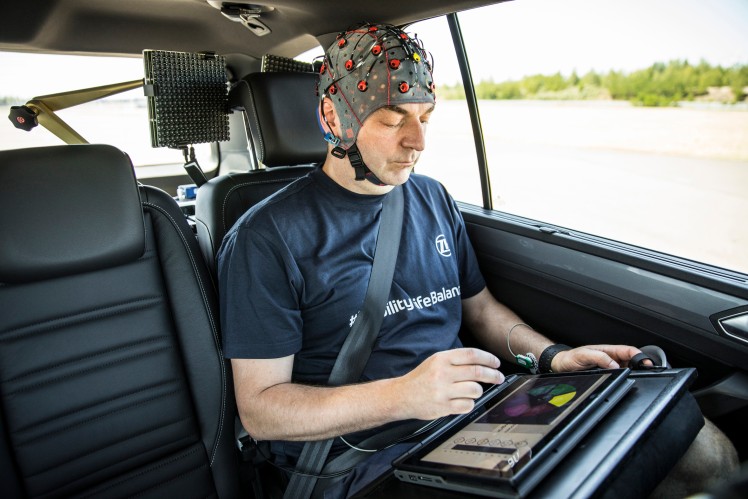ZF researches to counteract motion sickness - Prevention and reaction: ZF working to help counteract motion sickness before the occupant becomes motion sick, in cooperation with neuro-technologists
- Artificial intelligence uses driving dynamics and the physiological markers of motion sickness to develop driving styles that can help to prevent it
Friedrichshafen / Klettwitz (Germany). The comfort of occupants is a decisive factor for ZF as it relates to next generation mobility. For many people, long car journeys can be synonymous with dizziness, headaches, and nausea – in other words with motion sickness. ZF is working together with neuro-technologists from Germany’s Saarland region to investigate how to detect motion sickness at an early stage, and how to avoid a negative impact on the driving experience

On long car journeys, very few people are immune from it when seated in the back or on the front passenger seat. A sense of dizziness and motion sickness can preclude any attempt to enjoy the ride or to work while still on the road. ZF is going above and beyond this purely vehicle-based approach: “We are among the very first companies in this sector to place the occupants and their individual driving experience center stage”, states Florian Dauth, responsible in ZF Advanced Technology Development for activities in the field of Human Centered Vehicle Motion Control. “Our goal is to identify individual instances of motion sickness and to devise measures that relate to the prevailing condition of the passenger.”
The scientific basis for this concept is derived by test candidate studies that were conducted jointly by the Systems Neuroscience & Neurotechnology Unit (SNNU) at the Saarland University and htw saar. In these studies, the physiological reactions of test candidates were examined in a variety of driving situations. “Our pioneering research incorporates the fields of neuro-technology, psycho-physiology, artificial
intelligence and driving dynamics”, recounts Prof. Dr. Dr. Daniel J. Strauss, Director of the SNNU. “The respective skill sets of the partners complement one another perfectly in the context of this collaborative project. The scientific results obtained to date have been very well received by the international specialist community.”
Scientific data provides an insight into physiological processes
Motion sickness is caused by a discrepancy in perception: The balance organ in the inner ear senses a movement that is not confirmed by other sense organs such as the eyes. This is most likely to happen when a passenger is concentrating on a screen or a book. In this situation, the human body responds with a reaction that is in many ways similar to the response to poisoning. The symptoms range from a slight sense of unease to acute motion sickness.
In several studies, the researchers at ZF and SNNU analyzed the physiological markers that show the highest correlation with the subjective perception of motion sickness by individuals. They also examined how this correlates to the driving dynamics of a vehicle. “Our Motion Sickness Research Vehicle enables us, with the help of a high performance computing platform, to record the large number of physiological measuring data, camera data, and measurements relating to driving dynamics. At the same time, the vehicle serves as a platform for the development and validation of algorithms”, explains Dauth.
Over more than ten thousand kilometers, the team of researchers gathered more than fifty thousand gigabytes of physiological markers in the central and autonomous nervous system in the form of thermographic, imagery, and driving dynamic data. In this sector, this is a unique and multi-modal data resource on the subject of motion sickness. “It helps us to apply a scientific procedure to the task of gaining an understanding of the phenomenon of motion sickness, and is at the same time a basis for depicting AI-based algorithms”, states Dauth as he explains the development process.
People as the focal point
The research currently employs a set of sensors inside the vehicle and wearables for non-invasive measurement. “The challenge is to develop an automotive-compatible system that, over the number of evolutionary steps, enables motion sickness to be detected without physical contact. We view this as a crucial information to gain a firm grasp of the very individual phenomenon that is known as motion sickness”, states Dauth. With this, the driver – or at some later point the control system running the automated vehicle – can identify at an early stage if, by way of example, a child on the back seat is starting to feel ill, and can adapt driving characteristics accordingly.
The vehicle learns a preventive driving style
Everyone reacts differently to vehicle movements, and possesses an individual sense of ride comfort. At ZF, this fact is depicted in an algorithm based on ArtificiaI Intelligence methods that acquire knowledge of the physical reactions of each passenger, enabling a personalized profile to be created. As a consequence of this, individual data are obtained for every passenger in a vehicle, meaning that automated vehicles would actually be able to store the preferred driving style of each passenger.
- Prevention and reaction: ZF working to help counteract motion sickness before the occupant becomes motion sick, in cooperation with neuro-technologists
- Artificial intelligence uses driving dynamics and the physiological markers of motion sickness to develop driving styles that can help to prevent it
Friedrichshafen / Klettwitz (Germany). The comfort of occupants is a decisive factor for ZF as it relates to next generation mobility. For many people, long car journeys can be synonymous with dizziness, headaches, and nausea – in other words with motion sickness. ZF is working together with neuro-technologists from Germany’s Saarland region to investigate how to detect motion sickness at an early stage, and how to avoid a negative impact on the driving experience

On long car journeys, very few people are immune from it when seated in the back or on the front passenger seat. A sense of dizziness and motion sickness can preclude any attempt to enjoy the ride or to work while still on the road. ZF is going above and beyond this purely vehicle-based approach: “We are among the very first companies in this sector to place the occupants and their individual driving experience center stage”, states Florian Dauth, responsible in ZF Advanced Technology Development for activities in the field of Human Centered Vehicle Motion Control. “Our goal is to identify individual instances of motion sickness and to devise measures that relate to the prevailing condition of the passenger.”
The scientific basis for this concept is derived by test candidate studies that were conducted jointly by the Systems Neuroscience & Neurotechnology Unit (SNNU) at the Saarland University and htw saar. In these studies, the physiological reactions of test candidates were examined in a variety of driving situations. “Our pioneering research incorporates the fields of neuro-technology, psycho-physiology, artificial
intelligence and driving dynamics”, recounts Prof. Dr. Dr. Daniel J. Strauss, Director of the SNNU. “The respective skill sets of the partners complement one another perfectly in the context of this collaborative project. The scientific results obtained to date have been very well received by the international specialist community.”
Scientific data provides an insight into physiological processes
Motion sickness is caused by a discrepancy in perception: The balance organ in the inner ear senses a movement that is not confirmed by other sense organs such as the eyes. This is most likely to happen when a passenger is concentrating on a screen or a book. In this situation, the human body responds with a reaction that is in many ways similar to the response to poisoning. The symptoms range from a slight sense of unease to acute motion sickness.
In several studies, the researchers at ZF and SNNU analyzed the physiological markers that show the highest correlation with the subjective perception of motion sickness by individuals. They also examined how this correlates to the driving dynamics of a vehicle. “Our Motion Sickness Research Vehicle enables us, with the help of a high performance computing platform, to record the large number of physiological measuring data, camera data, and measurements relating to driving dynamics. At the same time, the vehicle serves as a platform for the development and validation of algorithms”, explains Dauth.
Over more than ten thousand kilometers, the team of researchers gathered more than fifty thousand gigabytes of physiological markers in the central and autonomous nervous system in the form of thermographic, imagery, and driving dynamic data. In this sector, this is a unique and multi-modal data resource on the subject of motion sickness. “It helps us to apply a scientific procedure to the task of gaining an understanding of the phenomenon of motion sickness, and is at the same time a basis for depicting AI-based algorithms”, states Dauth as he explains the development process.
People as the focal point
The research currently employs a set of sensors inside the vehicle and wearables for non-invasive measurement. “The challenge is to develop an automotive-compatible system that, over the number of evolutionary steps, enables motion sickness to be detected without physical contact. We view this as a crucial information to gain a firm grasp of the very individual phenomenon that is known as motion sickness”, states Dauth. With this, the driver – or at some later point the control system running the automated vehicle – can identify at an early stage if, by way of example, a child on the back seat is starting to feel ill, and can adapt driving characteristics accordingly.
The vehicle learns a preventive driving style
Everyone reacts differently to vehicle movements, and possesses an individual sense of ride comfort. At ZF, this fact is depicted in an algorithm based on ArtificiaI Intelligence methods that acquire knowledge of the physical reactions of each passenger, enabling a personalized profile to be created. As a consequence of this, individual data are obtained for every passenger in a vehicle, meaning that automated vehicles would actually be able to store the preferred driving style of each passenger.
MEDIA
CONTACT

Robert Buchmeier

